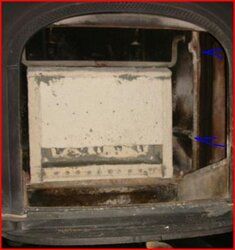I bought my stove used last year. I went through it and the secondary burn box was in tough shape but I ran it through the winter.
Since I found out that a replacement is $225 I've been threatening to try to make one from Kaowool board.
I made it tonight. It cost $80 for the Kaowool at a plumbing supply store. I could probably have spent less if it hadn't been spur-of-the-moment
and I had a better idea of sizes, etc. I bought a piece of 1"x20"x20" and 1/2"x18"x36".
Anyway, I had heard somewhere here that the box had baffles in it. Mine didn't. It turns out mine had crumbled away before I got it.
I looked at a new box today and saw the baffles. Between what I saw and the measurements I could get off my old box I made the box shown below.
I assembled it with furnace cement and 4d finish nails.
I don't know how well it will function or last. I'll probably button it all up and have my first burn tomorrow.
I'll post here when I have some results throughout the heating season. If it all works out I may make drawings for those that might want them.




Since I found out that a replacement is $225 I've been threatening to try to make one from Kaowool board.
I made it tonight. It cost $80 for the Kaowool at a plumbing supply store. I could probably have spent less if it hadn't been spur-of-the-moment
and I had a better idea of sizes, etc. I bought a piece of 1"x20"x20" and 1/2"x18"x36".
Anyway, I had heard somewhere here that the box had baffles in it. Mine didn't. It turns out mine had crumbled away before I got it.
I looked at a new box today and saw the baffles. Between what I saw and the measurements I could get off my old box I made the box shown below.
I assembled it with furnace cement and 4d finish nails.
I don't know how well it will function or last. I'll probably button it all up and have my first burn tomorrow.
I'll post here when I have some results throughout the heating season. If it all works out I may make drawings for those that might want them.


